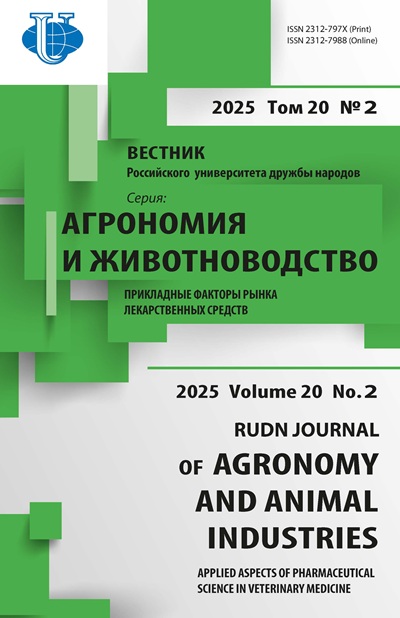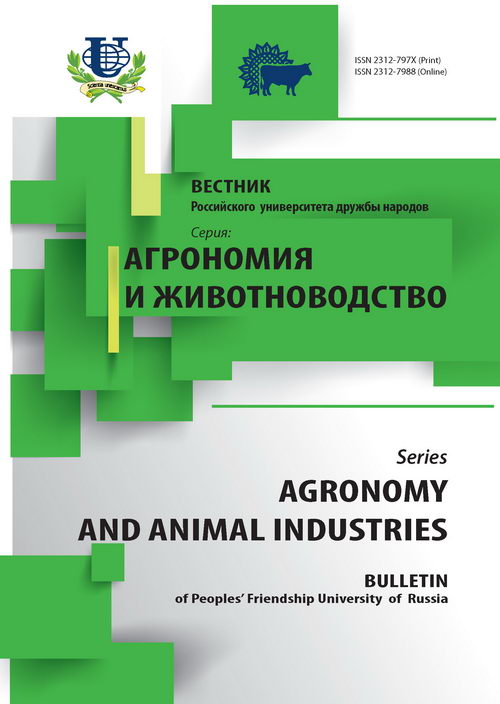No 3 (2016)
- Year: 2016
- Articles: 11
- URL: https://agrojournal.rudn.ru/agronomy/issue/view/857
- DOI: https://doi.org/10.22363/2312-797X-2016-3
Full Issue
Articles
Leaf pigment content and accumulation of dry matter by potato plant as affected by sulfate fertilizer in green house experiment
Abstract
From the time mineral fertilizers were used single superphosphate have been the main source of phosphate in plant nutrition. This fertilizer contains nor only 19-21% of P2O5 but also sulfate in form of gypsum and small amount of sulfuric acid. As a result, application of one kg of superphosphate enriched the soil with 80-100 g of sulfates. During last 40-50 years single superphosphate was replaced by concentrated mineral fertilizers which contain up to 42-52% of P2O5. And now on some soils the main source of sulfurbecome precipitations which bring sulfur oxides produced by chemical enterprises and exhaust fumes of machinery. As a consequence of this there are not rear cases when growing plants, and more often legumes, oil and root corps, show signs of sulfur deficit. Optimal levels of sulfur content in plant leaves well established. But there is obvious interest to get more objective data on physiological processes which are more sensitive to deficit of this plant nutrient and on preferable time of sulfur application. Influence of sulfate and other anions of potassium fertilizers on leaf pigment content and accumulation of dry matter by potato plants are presented and discussed in the article.
RUDN Journal of Agronomy and Animal Industries. 2016;(3):7-15
 7-15
7-15


The efficacy of insecticides against Psylla Pyri L. in the conditions of the 2013-2015 ccr
Abstract
One of the major pests of pear is a pear psylla (Psylla pyri L.), which in large amount, can cause the death of pear plantations. Currently assortment of preparation approved for application in pear plantations, does not provide effective protection against the pear psylla. In the conditions of growing seasons 2013-2015, the preparations Actara WG (250 g/kg), Dimilin, WP (250 g/kg), Vertimek, EC (18 g/l), Decis Profi, WG (250 g/kg), Bi-58 New EC (400 g/l), Calypso, SC (480 g/l) were tested on pear plants varieties Osennaya Yakovleva to protect against the massive spread of pear psylla. Preparations were applied as well univariate as in tank mixtures. Monitoring weather conditions and analysis of pear psylla’s development during the growing season let to reduce the pesticide load in the plantations of fertile pear and increase profitability pear fruit production. Depending on weather conditions and the degree of development of the pest, used insecticides showed different efficiency. The highest expansion and development of pear psylla were occurred by the weather conditions in 2014 and 2015 (the optimum temperature and humidity, low rainfall); unfavorable for pest development was 2013 (frequent and abundant precipitation). The Most long-term biological effectiveness to control pear psylla, regardless of weather conditions, achieved through the application of a tank mixture Dimilin, WP + Actara, WG (biological efficiency = 85-98%). High biological efficiency of Dimilin, WP, Actara, WG and Vertimek, EC univariate (BE = 78-95%) was achieved by applying them at a low number of pear psylla.
RUDN Journal of Agronomy and Animal Industries. 2016;(3):16-21
 16-21
16-21


Some perspectives of use metabolites of the genus Trichoderma
Abstract
The article provides an overview of studies that focus on some perspectives of using the metabolites of the genus Trichoderma . These metabolites can be used in the creation of protection products in the fight against plant diseases viral or bacterial origin. In the article presents the work of Russian and foreign researchers. Special attention is given to research the products of metabolism multifunctional strain of Trichoderma harzianum Rifai F-180, which are carried out over a number of years in the Medical Institute of the Peoples' Friendship University of Russia at the department of Biochemistry, the use of the culture fluid of the saprophytic fungus and enzyme L-lysine-a-oxidase as an inhibitor of a number of highly dangerous human diseases and of highly dangerous plant diseases that have bacterial and viral origin.
RUDN Journal of Agronomy and Animal Industries. 2016;(3):22-29
 22-29
22-29


Agroecological estimation of the mineralogical composition of the soil
Abstract
It is shown that the mineralogical composition of the soil is a factor when considering the lithology of soil at a lower hierarchical level. The mineralogical composition and determines the content ratio in the soil of nutrients and toxicants, ion exchange processes, soil resistance to degradation of soil fertility. It is the matrix of the formation of soil and regulates the transformation, migration and accumulation in soil of substances, energy and information of environmental and human impact.
RUDN Journal of Agronomy and Animal Industries. 2016;(3):30-39
 30-39
30-39


Soil-ecological characteristic of the Forest experimental station of Russian State Agrarian University of Moscow Agricultural Academy by K.A. Timiryazev under plantings in the conditions of various anthropogenous loading
Abstract
The heavy metals circulating in the biosphere have a huge negative impact on ecosystem components. At the same time however, the real danger from the environmental pollution by the heavy metals (HM) is constituted not by gross volume of metals, but by their mobile forms as the last practically define the accumulation of elements in biomass and influence the biological activity of soils. Meanwhile, the level study of this question is very weak. The influence of soil consolidation on HM mobility is almost not unknown. In this regard at wood sites with unequal anthropogenic loading we have conducted researches which have demonstrated the dependence of toxic heavy metals forms, diverse by durability of communication, on the consolidation of soil. In many respects the density of soil profile defines the formation of the soil modes - water-air, temperature, oxidation-reduction, biochemical, and often makes decisive impact on demonstration of the soil main ecological functions, conditions of growth, development and efficiency of plants, microorganisms activity and soil fauna.
RUDN Journal of Agronomy and Animal Industries. 2016;(3):40-45
 40-45
40-45


The study of the morphology and the lipid complex of the seeds of Plantago psyllium L., and Plantago ovate Forssk., in comparative aspect
Abstract
In a comparative perspective a study of the morphology of the seeds of two species of plantain bloshnogo and p. ovale. The basic characteristics of these seeds to establish their authenticity by their appearance. These include size, shape, color of the seed coat. Studied the yield of extractive substances extracted with n-hexane from the seeds (6% for p. ovale, and 4% for p. bloshnogo), and by H1 NMR spectroscopy - some characteristics of triacylglycerides in the seed oil of p. bloshnogo that allow you to relate it to poluvysyhayuschee type of fatty oils.
RUDN Journal of Agronomy and Animal Industries. 2016;(3):46-51
 46-51
46-51


Morphological composition of carcasses and muscle development of eland antelope
Abstract
The absolute weight of carcasses of Eland antelope calves from 6 months of age to adulthood increases in 3.78 times, muscle - in 4.01, fat tissue - 7.3, bone tissue - 2.79 and other tissues - 3.53. The relative mass of muscle tissue increases by 4.66%, adipose tissue - 0.95%, but the bone tissue reduces by 5.47% and other tissue - 0.13%. The absolute mass of the axial muscle department of adult bulls increases compared with 6-month-old calves by 4.51 times, while the relative mass increases by 5.53%; peripheral skeleton department - 3.61 times, but is reduced to 5.53%. With age, the relative weight of shoulder girdle muscles of calves increases by 2.01%, the vertebral column - 3.73%, the abdominal wall - 0.87%, the shoulder blade - 0.87%, but decreases in the chest wall - 0.21%, in the forearm - 0.60, in the pelvic girdle - 0.57, in the hip - 3.82 and in the shin - 1.36%.
RUDN Journal of Agronomy and Animal Industries. 2016;(3):52-56
 52-56
52-56


Structural changes in rats organism in experimental intoxication with herbicide 2,4-DA
Abstract
In subacute toxicity herbicide 2,4-DA LD50, in the macroscopic examination of organs in rats set changes inherent poisoning by toxic substances. Heart muscle and kidneys flabby, uneven coloring. Lung red-pink color with areas of acute atelectasis. By light and electron microscopy, we found that the herbicide 2,4-DA has polytropic effect on experimental animals. In the myocardium revealed foci of necrosis where cardiomyocytes have fuzzy outlines and poor color. Structural changes are accompanied by an increase in the number of infiltration of lymphocytes and macrophages. In the kidneys due to necrotic and degenerative changes in the tubules of nephrons organ's parenchyma becomes grayish color. In the walls of medium and small bronchi of lung localized massive lymphocytic infiltration. The interalveolar septum tissue greatly expanded due to the large number of white blood cells. In all investigated organs disorders found blood and lymph circulation.
RUDN Journal of Agronomy and Animal Industries. 2016;(3):57-64
 57-64
57-64


Prevention of mixed respiratory infections in young cattle
Abstract
The possibility of use of phytomedicine in conjunction with hyperimmune serum of animal donors to enhance the preventive effectiveness at mixed respiratory infections in calves was studied. In a farm in Nizhny Novgorod region with unfavorable in terms of mixed respiratory infections of viral and bacterial etiology a high level of morbidity (80%) and mortality (26%) was revealed. Before use of medicines in clinically healthy calves aged 20-30 days mild immunodeficiency was found characterizing by decrease in relative T-cell content by 20.0%, functional activity of blood neutrophils in spontaneous and induced tests by 19.0%, lysozyme activity by 29.0% when compared with minimum value of the physiological norm for this age period. On the background of the immunological imbalance drastically decreases the effectiveness of traditional therapies. Use of Maxophyt in conjunction with hyperimmune serum of donor animals promoted statistically significant rise in initially reduced immunological parameters and intense specific immunity in clinically healthy calves: absolute and relative T- and B-cell content increased by 36.0%, 38.0% and 50.0%, 67.0% respectively, functional activity of blood neutrophils in spontaneous and induced tests by 18.0% and 32.0%, IgG and IgM levels by 46.0% and 53.0% respectively, lysozyme activity of blood serum by 60.0%. Subcutenous injection of hyperimmune serum of donor animals in conjunction with aerosol treatment with phytomedicine Maxophyt enhanced the preventive effectiveness at mixed respiratory infections of viral and bacterial etiology to 96.2% which was 21.2% higher when compared with the control and average daily body weight gain to 890.0 ± 22.8 g which was 26.0% higher when compared with the control. Combination of medicines provided the 100% safety of calves in experimental groups which was 8.3% higher when compared with the control. The course of disease in experimental calves was mild.
RUDN Journal of Agronomy and Animal Industries. 2016;(3):65-71
 65-71
65-71


Indication and identification of infectious agents in animal products based on biochip technology with a biotin label and colorimetric detection
Abstract
The results of the development of DNA chips with biotin uterus and colorimetric detection to indicate and identify pathogens in animal products. The constant need to monitor for dangerous infectious diseases makes the urgency of developing new effective methods of identification of pathogens of these diseases. The high specificity and sensitivity of the technique, is 103-104 bacterial cells. The analysis takes 5-7 hours. Visual assessment of the end result allows for biochip test systems in stationary and field conditions, laboratories and regional reference centers. The application of modern biochip technology research quickly and with high reliability to detect infectious agents in a variety of biological materials, typified by strains in order to establish a common source of infection.
RUDN Journal of Agronomy and Animal Industries. 2016;(3):72-78
 72-78
72-78


Our authors
RUDN Journal of Agronomy and Animal Industries. 2016;(3):79-82
 79-82
79-82
















